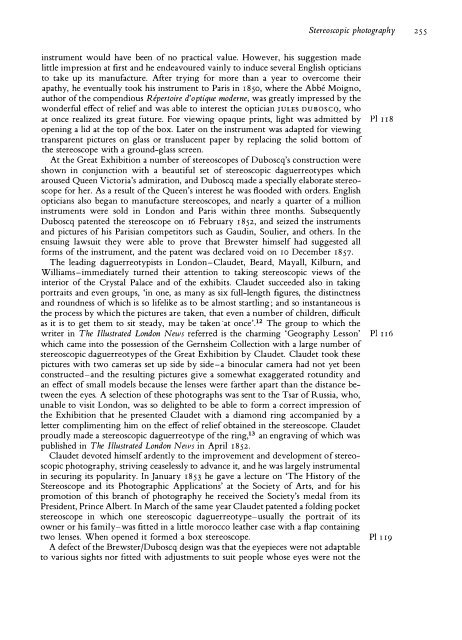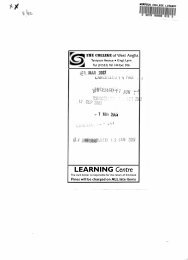Helmut Gernsheim & Alison Gernsheim, The History of Photography: From the Camera Obscura to the Beginning of the Modern Era
Helmut Gernsheim & Alison Gernsheim, The History of Photography: From the Camera Obscura to the Beginning of the Modern Era
Helmut Gernsheim & Alison Gernsheim, The History of Photography: From the Camera Obscura to the Beginning of the Modern Era
Create successful ePaper yourself
Turn your PDF publications into a flip-book with our unique Google optimized e-Paper software.
Stereoscopic pho<strong>to</strong>graphy 2 5 5<br />
instrument would have been <strong>of</strong> no practical value. However, his suggestion made<br />
little impression at first and he endeavoured vainly <strong>to</strong> induce several English opticians<br />
<strong>to</strong> take up its manufacture. After trying for more than a year <strong>to</strong> overcome <strong>the</strong>ir<br />
apathy, he eventually <strong>to</strong>ok his instrument <strong>to</strong> Paris in 1850, where <strong>the</strong> Abbe Moigno,<br />
author <strong>of</strong> <strong>the</strong> compendious Reper<strong>to</strong>ire d' optique moderne, was greatly impressed by <strong>the</strong><br />
wonderful effect <strong>of</strong> relief and was able <strong>to</strong> interest <strong>the</strong> optician JULES DUBOSCQ, who<br />
at once realized its great future. For viewing opaque prints, light was admitted by Pl l l 8<br />
opening a lid at <strong>the</strong> <strong>to</strong>p <strong>of</strong> <strong>the</strong> box. Later on <strong>the</strong> instrument was adapted for viewing<br />
transparent pictures on glass or translucent paper by replacing <strong>the</strong> solid bot<strong>to</strong>m <strong>of</strong><br />
<strong>the</strong> stereoscope with a ground-glass screen.<br />
At <strong>the</strong> Great Exhibition a number <strong>of</strong> stereoscopes <strong>of</strong> Duboscq's construction were<br />
shown in conjunction with a beautiful set <strong>of</strong> stereoscopic daguerreotypes which<br />
aroused Queen Vic<strong>to</strong>ria's admiration, and Duboscq made a specially elaborate stereoscope<br />
for her. As a result <strong>of</strong> <strong>the</strong> Queen's interest he was flooded with orders. English<br />
opticians also began <strong>to</strong> manufacture stereoscopes, and nearly a quarter <strong>of</strong> a million<br />
instruments were sold in London and Paris within three months. Subsequently<br />
Duboscq patented <strong>the</strong> stereoscope on 16 February l 8 52, and seized <strong>the</strong> instruments<br />
and pictures <strong>of</strong> his Parisian competi<strong>to</strong>rs such as Gaudin, Soulier, and o<strong>the</strong>rs. In <strong>the</strong><br />
ensuing lawsuit <strong>the</strong>y were able <strong>to</strong> prove that Brewster himself had suggested all<br />
forms <strong>of</strong> <strong>the</strong> instrument, and <strong>the</strong> patent was declared void on IO December 1857.<br />
<strong>The</strong> leading daguerreotypists in London-Claudet, Beard, Mayall, Kilburn, and<br />
Williams-immediately turned <strong>the</strong>ir attention <strong>to</strong> taking stereoscopic views <strong>of</strong> <strong>the</strong><br />
interior <strong>of</strong> <strong>the</strong> Crystal Palace and <strong>of</strong> <strong>the</strong> exhibits. Claudet succeeded also in taking<br />
portraits and even groups, 'in one, as many as six full-length figures, <strong>the</strong> distinctness<br />
and roundness <strong>of</strong> which is so lifelike as <strong>to</strong> be almost startling ; and so instantaneous is<br />
<strong>the</strong> process by which <strong>the</strong> pictures are taken, that even a number <strong>of</strong> children, difficult<br />
as it is <strong>to</strong> get <strong>the</strong>m <strong>to</strong> sit steady, may be taken ·at once'.12 <strong>The</strong> group <strong>to</strong> which <strong>the</strong><br />
writer in <strong>The</strong> Illustrated London News referred is <strong>the</strong> charming 'Geography Lesson' Pl l 16<br />
which came in<strong>to</strong> <strong>the</strong> possession <strong>of</strong> <strong>the</strong> <strong>Gernsheim</strong> Collection with a large number <strong>of</strong><br />
stereoscopic daguerreotypes <strong>of</strong> <strong>the</strong> Great Exhibition by Claudet. Claudet <strong>to</strong>ok <strong>the</strong>se<br />
pictures with two cameras set up side by side-a binocular camera had not yet been<br />
constructed-and <strong>the</strong> resulting pictures give a somewhat exaggerated rotundity and<br />
an effect <strong>of</strong> small models because <strong>the</strong> lenses were far<strong>the</strong>r apart than <strong>the</strong> distance between<br />
<strong>the</strong> eyes. A selection <strong>of</strong> <strong>the</strong>se pho<strong>to</strong>graphs was sent <strong>to</strong> <strong>the</strong> Tsar <strong>of</strong> Russia, who,<br />
unable <strong>to</strong> visit London, was so delighted <strong>to</strong> be able <strong>to</strong> form a correct impression <strong>of</strong><br />
<strong>the</strong> Exhibition that he presented Claudet with a diamond ring accompanied by a<br />
letter complimenting him on <strong>the</strong> effect <strong>of</strong> relief obtained in <strong>the</strong> stereoscope. Claudet<br />
proudly made a stereoscopic daguerreotype <strong>of</strong> <strong>the</strong> ring,13 an engraving <strong>of</strong> which was<br />
published in <strong>The</strong> Illustrated London Nel/Js in April l 8 52.<br />
Claudet devoted himself ardently <strong>to</strong> <strong>the</strong> improvement and development <strong>of</strong> stereoscopic<br />
pho<strong>to</strong>graphy, striving ceaselessly <strong>to</strong> advance it, and he was largely instrumental<br />
in securing its popularity. In January 1853 he gave a lecture on '<strong>The</strong> <strong>His<strong>to</strong>ry</strong> <strong>of</strong> <strong>the</strong><br />
Stereoscope and its Pho<strong>to</strong>graphic Applications' at <strong>the</strong> Society <strong>of</strong> Arts, and for his<br />
promotion <strong>of</strong> this branch <strong>of</strong> pho<strong>to</strong>graphy he received <strong>the</strong> Society's medal from its<br />
President, Prince Albert. In March <strong>of</strong> <strong>the</strong> same year Claudet patented a folding pocket<br />
stereoscope in which one stereoscopic daguerreotype-usually <strong>the</strong> portrait <strong>of</strong> its<br />
owner or his family-was fitted in a little morocco lea<strong>the</strong>r case with a flap containing<br />
two lenses. When opened it formed a box stereoscope. Pl l 19<br />
A defect <strong>of</strong> <strong>the</strong> Brewster/Duboscq design was that <strong>the</strong> eyepieces were not adaptable<br />
<strong>to</strong> various sights nor fitted with adjustments <strong>to</strong> suit people whose eyes were not <strong>the</strong>









